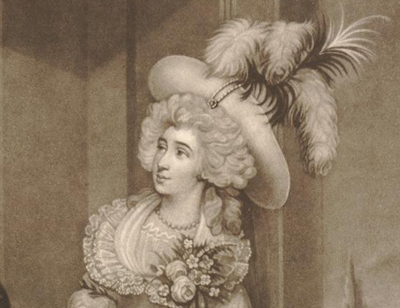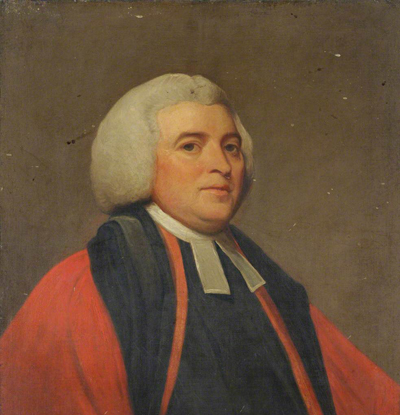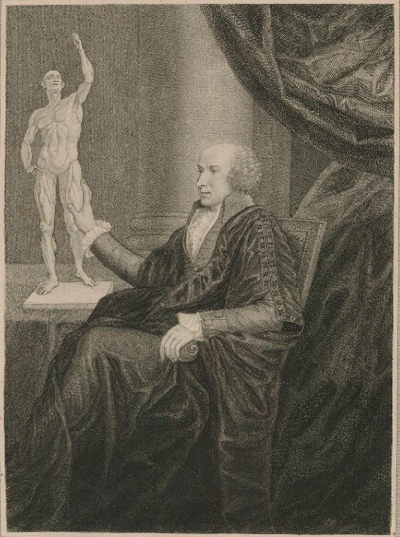Matins at D-wn-ng College
This is one of four prints relating to Cambridge University created by an amateur and etched by Gillray in the last two years of his productive life. The others include:
- A Petty Professor of Modern History, Brought to Light
- Bristol Cheese, Made & Sold by Percival & Co_
- Cambridge Commencement Sermon
Stylistic similarities among the prints, as well as the common Cambridge focus, make it likely that the same amateur was responsible for all four. But in this case, the visual tics of clouds and drapery that appear simply odd in the other Cambridge prints are much better integrated into what seems to be a quirky portrayal of a professor and wife smoking in bed. And the crude ad hominem attacks that characterize the other prints seem at first to be absent from Matins.

© Trustees of the British Museum
According to the Episcopal Dictionary of the Church, matins are part of the Horae Canonicae, the Canonical Hours, a daily cycle of prayers offered at more or less specific times of day.
The seven "hours" are: matins and lauds (usually counted as a single hour), in the middle of the night; prime, at sunrise; terce, 9 a.m.; sext, noon; none, 3 p.m.; vespers, sunset; and compline, bedtime.
The performance of the complete set of canonical hours was and still is usually reserved for monks. So assuming the title is accurate, the setting for the print would be "in the middle of the night." Not surprisingly, then, most commentators follow Thomas Wright and R.H. Evans in assuming that Matins portrays Sir Busick Harwood, Professor of Anatomy at Downing College, and his wife, the former Elizabeth Peschell. Busick is identified by the note on the bed in from of him: Sir,— be you Sick," i.e. B U Sick.
But a 2018 article by Jenny Ulph in the Downing College Alumni Association Newsletter (pp.40-44) has called into question the identification of Sir Busick's bedfellow as his wife, Elizabeth Peschell, and provided convincing arguments for identifying his rather portly partner as (shockingly) Richard Farmer, Master of Emmanuel College, University Librarian, and Vice-Chancellor.

© Trustees of the British Museum

Richard Farmer
[~1770|
© Wikipedia
For one thing, the only portrait we have of Elizabeth Peschell shows a slim and rather elegant-looking woman who looks nothing like the bulky and decidedy old-fashioned figure next to Sir Busick. But it DOES resemble portraits of Farmer. Next, there are at least two different sources (mentioned by Ulph) close to Cambridge and its history that make reference to the print and identify Farmer as Harwood's bedfellow. And finally there is a host of circumstantial evidence which points to an unusual (and unusually close) relationship between the two.
Busick Harwood seems to have been ambitious, somewhat irascible fellow, and a confirmed bachelor for most of his life.* He was apprenticed to an apothecary and qualified as a surgeon, but saw an opportunity to gain both wealth and experience in India where, according to Henry Gunning whose Reminiscences. . . provide the best available information about Harwood, he could count as patients "natives of the highest distinction, who. . . paid him with princely liberality." (Gunning p. 47) Upon his return to England with an apparently healthy store of cash, he was admitted as a "Fellow-Commoner of Christ's College."
He lived in an expensive style, gave frequent dinners, and also wine parties: to the latter he invited, in their turns, all the undergraduates, and became very popular with men of all ages. He was a person of considerable wit, according to the fashion of those days, but such as would not be tolerated at the present time : his conversation was profligate and licentious in the extreme, notwithstanding which he was in the habit of living on the most intimate terms with men of the highest station in the University. (Gunning pp.47-48)
In spite of being popular and well-situated at Christ College, in 1785 Harwood moved to Emmanuel College for what Gunning suggests were political reasons switching allegiance from Whig to Tory, and becoming Professor of Anatomy.(Gunning p. 49) It was there that he would have met Richard Farmer who was Master of Emmanuel, a staunch Pittite, who shared his interest in good food and fine wines.
They seem to have become fast friends. As early as 1787, Harwood dedicated his major publication, Synopsis of a Course of Lectures on Anatomy and Physiology to Farmer 'by his most obedient humble servant.' And in the same year, as Ulph explains,
Harwood was involved in the surprise termination of Dr Farmer's marriage proposal to a daughter of Sir Thomas Hatton, after the Baronet's death in 1787. Gunning writes that 'Farmer employed Harwood to communicate to the lady his change of sentiments. A more unsuitable ambassador could not have been selected to make a communication of so delicate a nature; though it was a prevailing opinion that Farmer could scarcely have employed a more willing envoy, as Harwood was for the most part a resident at the Lodge, and his position there must have been considerably changed by Farmer's marriage. Both Harwood and Farmer were attacked with epigrams without end...' p. 42.
The epigrams referred to in this case have not yet been found. But if the epigrams published in The Battle between Doctor Farmer and Peter Musgrave, the Cambridge Taylor in Hudibrastic Verse serveral years later in 1792 are any indication, Farmer's uncertain sexuality was likely the subject. Here are a couple of samples that make much of a scarlet cod-piece he seems to have worn. (pp-13-14)
In a public debate
On affairs of the State
The Doctor talks bold of the c*d-piece.
But in private affairs
The Doctor declares
The ladies would think him an odd-piece.
Dear Doctor pray cease
And of your c*d-piece
Ne'er make such a terrible rattle
For tho you may brag
Of your flaming red rag,
The cod, my good Sir's half the battle.
And finally, one entitled "The Disapppointment, or the Enraged Damsel's Address to the Doctor."
And is this all, the Damsel cries
Thou flaming c*d-piec'd varlet?
A piece of c*d's the thing I prize,
And not a piece of scarlet.
Farmer seems to have been a patron of a young painter named Sylvester Harding. Eager to please Farmer and no doubt himself, (according to Gunning) Harwood
requested all the members of the University with whom he was at all acquainted, of whatever age or station, to sit for their portraits ; and as the charge was moderate, and the likenesses very striking, but few refused compliance. When they were completed, he had about six or eight placed in a frame, and hung in his room.**
(Gunning, p. 50)
This practice apparently provided an opportunity to another Cambridge wit (also caricatured by Gillray), William Lort Mansell, "of showing his dislike to Harwood, by a very lively but very obscene epigram, which bore hard on the persons of whose portraits Harwood was in possession. The Professor retorted by an epigram, not so lively but equally obscene." (Gunning, pp. 50-51)
Again, we have no record of either epigram, but another miniature portrait, this time of Harwood himself, may suggest that Harwood's exploration of anatomy with his students, in some cases, might have been more hands-on than was traditional.

© National Portrait Gallery, London
Since 1533 in Henry VIII's time, the official stance of British law was that sodomy was a crime, punishable, in fact, by death. And after 1760, prosecutions were on the rise. So a print showing Sir Busick and Richard Farmer in bed together was certainly a bold attack, easily as damaging as the attacks in the other three Cambridge prints. But because there is nothing that conclusively identifies Farmer as Busick's bedfellow, there is plenty of deniability on the side of both artist and subject.
* He married in July 1798 at the age of 53, less than a year after Richard Farmer's death. According
to Raymond Williamnson, (p.424) "His friends looked upon Harwood as a confirmed bachelor because he was in "the habit of speaking of
the married state in strong terms of reprobation". It was, therefore, a great surprise when during
dinner at Christ's he suddenly said, "I am going to do a devilish foolish thing, I am going to get
married". In the CombinationRoom afterwards, he told the Fellows that the lady was Miss Peschell,
the only daughter of Sir John Peschell, Bart. Although Harwood's acquaintances knew that the lady was
not wealthy, they suspected a mercenary motive behind the engagement.Gunning surmised that, as
both Harwood and Miss Peschell were favourites of Dr Glynn,6 an old, wealthy medical practitioner in
the town, they hoped to be beneficiaries in his will.7 They were married at St Botolph's church by
the Master ofPembroke College on 21 July 1798, and Dr Glynn gave the bride away. On his deathin
1800, Glynn left them £100 each."
** These portrait miniatures can still be seen at the University
of Cambridge Digital Library.
Sources and Reading
- Commentary from the British Museum on Matins at D-wn-ng College.
- "Busick Harwood," Wikipedia
- Jenny Ulph, "Unravelling the Mystery of Sir Busick Harwood's Bedfellow," Downing College Alumni Association Newsletter pp. 40-44.
- "Richard Farmer," Wikipedia
- "Canonical Hours," An Episcopal Dictionary of the Church
- "Liturgy of the Hours," Wikipedia
- Henry Gunning, Reminiscences of the University, Town, and County of Cambridge, from the year 1780pp. 46ff, 58ff
- The Battle between Doctor Farmer and Peter Musgrave, the Cambridge Taylor in Hudibrastic Verse, 1792.
- Raymond Williamson "Sir Busick Harwood: A Reappraisal," Cambridge Journals Medical History 1983, p. 424
- Thomas Wright and R.H. Evans, Historical and Descriptive Account of the Caricatures of James Gillray #580.
- Thomas Wright and Joseph Grego, The Works of James Gillray, the Caricaturist; With the History of His Life and Times, p. 370.
Comments & Corrections
NOTE: Comments and/or corrections are always appreciated. To make that easier, I have included a form below that you can use. I promise never to share any of the info provided without your express permission.